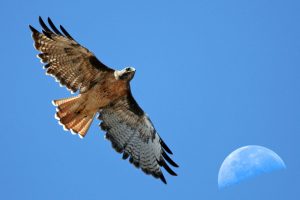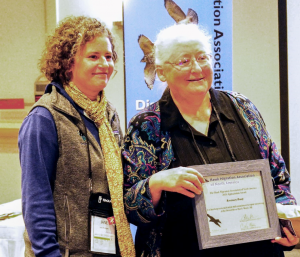
Inspiring a Sense of Wonder Through Raptors
A group of dedicated volunteers awoke before sunrise to arrive early on autumn mornings at a small patch of land in Lake Erie Metropark in Brownstown, Michigan. It is an appealing view overlooking the conservation crescent – a curved archipelago of islands and associated habitats that span the lower Detroit River as it enters Lake Erie.
The land where they gather is nondescript, with grass and a few picnic tables. But when they look up they are often treated to a spectacle of thousands of raptors soaring and swirling in the air as the day progresses.
This is what attracts Rosemary Brady and other dedicated volunteers like Andrew Sturgess, Patrick Malawa, Frank Kitakis, Raburn Howland, John Eliot, Mark Hainen and Don Sherwood to participate in Detroit River Hawk Watch. Each fall hundreds of thousands of raptors migrate across the lower Detroit River from their eastern Canadian breeding grounds and head south to their wintering grounds. Some of the birds fly as far as South America.
These raptors are birds of prey that hunt food primarily by flight, using their keen senses, chiefly vision. Examples of raptors include broad-winged hawks, bald eagles, peregrine falcons, osprey, and others.
Raptors use thermals, to varying degrees, to save energy during their long migration. Thermals are rising columns of warm air caused by the heating of the earth by the sun. A raptor will literally ride up on a thermal, set its wings, and glide downward to the next thermal using little energy.
Thermals do not form over water, so when raptors heading south come upon lakes Erie and Ontario, they have one of two choices: fly east around Lake Ontario or fly west around Lake Erie.
Those that move west follow the northern shore of Lake Erie until they reach the mouth of the Detroit River. Turning back is not an option, so they are forced to cross the four-mile river mouth near Lake Erie Metropark in southeast Michigan and a sister site at Holiday Beach in southwest Ontario.
These raptors lose altitude as they cross the lower river, making it easier for them to be observed.
To give you a feel for the size of hawk migrations through the lower Detroit River, volunteers recorded an amazing 190,121 broad-winged hawks on September 17, 2011, representing the 3rd highest single-day total recorded at this site.
As a casual birder, Rosemary enjoyed adding new birds to her list wherever she lived or traveled. Rosemary and her late partner, James Lichorat, moved to Michigan in 1977, but only discovered this raptor phenomenon in the early 1990s while attending Hawkfest at Lake Erie MetroPark that attracts about 5,000 people each year.
They were fascinated by the number of birds overhead, as well as the watchers’ abilities to identify what to their inexperienced eyes were often only distant, fast moving specks. There was little chance of seeing plumage marks on the birds, but somehow the hawk watchers were able to identify and count them.
Rosemary and Jim got hooked and with some help from hawk identification workshops and experienced hawk watchers they improved their skills and joined the hawk watch team.
Rosemary’s first experience with birding was at the age of 4 with her Grandma Loretta watching robins raise a nest full of babies. Growing up in the Finger Lakes region of upstate New York along the eastern flyway, she associated the calls of migrating Canadian Geese as heralds of approaching winter or the much longed-for arrival of spring to the snow belt.
Another formative birding experience occurred during college when she observed a flock of Northern Flickers methodically “anting” outside her grad school apartment. She couldn’t believe their striking markings – they looked like something made up by a kid with a box of crayons, not to mention their behavior – marching like a line of soldiers methodically turning over winter-rotted leaf litter searching for something that they then appeared to rub into their feathers. She later learned this behavior is called “anting” where the birds rub formic acid from the ants’ bodies on themselves as a natural pesticide. She acquired a sense of wonder about birds and was intrigued with understanding their behavior.
Before retiring in 2013, Rosemary worked for 34 years for AkzoNobel Coatings, a Dutch manufacturer of automotive and industrial paints. Much of that time she was responsible for their analytical laboratory, analyzing paint-related problems using instrumental, microscopic, and chemical methods. It was enjoyable detective work, sort of like CSI, but no blood. Happily, she now has more time to spend on her hawk-watch passion.
For Rosemary and her fellow watchers, the annual migration of raptors, turkey vultures, swans, jays, crows, butterflies, and dragonflies they see is a “life-affirming event.”
On a big day, seeing over 10,000 broad-winged hawks is a thrill; on other days, the variety of bird species is a delight. She admits finding the birds in a big sky and then identifying them before they are out of sight is often a challenge, but also great fun, and the other watchers are always helpful.
Detroit River Hawk Watch data are entered into the Hawk Migration Association of North America database to help understand raptor population trends on a continental scale . This is an example of citizen science or public participation in scientific research and monitoring.
For Rosemary, citizen science is like crowd-funding. One individual or even a few, or a single watch site, can’t do it alone, even if they are trained scientists. But if many citizen scientists participate, combined together there is the potential to achieve something worthwhile. With the current climate change in progress, it seems more important than ever to consider population monitoring as sentinel duty.
Rosemary believes that there are two ongoing challenges for the Detroit River Hawk Watch, which is coordinated by the Detroit River International Wildlife Refuge.
The first is funding for a professional, paid counter. Her late partner Jim helped secure the first corporate support from DTE Energy for such a position. The International Wildlife Refuge Alliance, Friends Organization for the Refuge, helps sustain funding and coordinates outreach at annual Hawkfests at Lake Erie Metropark.
The second is volunteer staffing. Volunteers are needed every day from September through November. Some work a few hours a week, others almost every day to assist the paid counter to spot, identify, and count raptors. Others who can’t make the daily watch like Jerry Jourdan and Will Weber work offsite to post daily reports online, analyze data, write season wrap-up reports, maintain a website, and prepare outreach literature.
Benefits of participating in Detroit River Hawk Watch include:
- developing a personal connection to the Detroit River;
- helping track raptor migrations that provide an early warning signal for changes in trends;
- gaining an understanding of environmental and natural resource problems, challenges, and needs;
- learning scientific methods and how science contributes to management;
- getting personal satisfaction from being involved in natural resource management; and
- helping improve scientific literacy and develop a stewardship ethic.
Rosemary’s advice is to go often, be patient, bring the best optics your budget can tolerate, and learn from fellow birders. And don’t forget that it can be a heck of a lot of fun.
For Rosemary’s efforts she received a 2018 Appreciation Award from the Hawk Migration Association of North America for her contributions to Detroit River Hawk Watch.
Clearly, the need for and interest in citizen science is growing. Today, 80 percent of all Americans and Canadians live in urban areas. Most urban residents are still disconnected from the natural world.
A “citizen science spring” would help reconnect people with nature and inspire a stewardship ethic.
If interested, visit the Detroit River Hawk Watch website HERE, visit the Lake Erie Metropark hawk watch on site September through November, or check it out during Hawkfest each September.
Featured Image: Detroit River Hawk Watch volunteers counting raptors crossing the Detroit River, Photo by Jerry Jourdan via John Hartig
Editor’s Note: Before becoming a contributor for Great Lakes Now, Dr. John Hartig served 14 years as Refuge Manager for the Detroit River International Wildlife Refuge.
1 Comment
-
For more about the Detroit River Hawk Watch, visit their website at http://detroitriverhawkwatch.org/.








